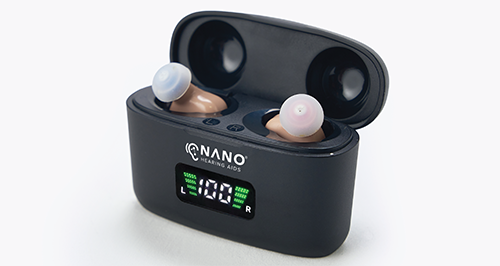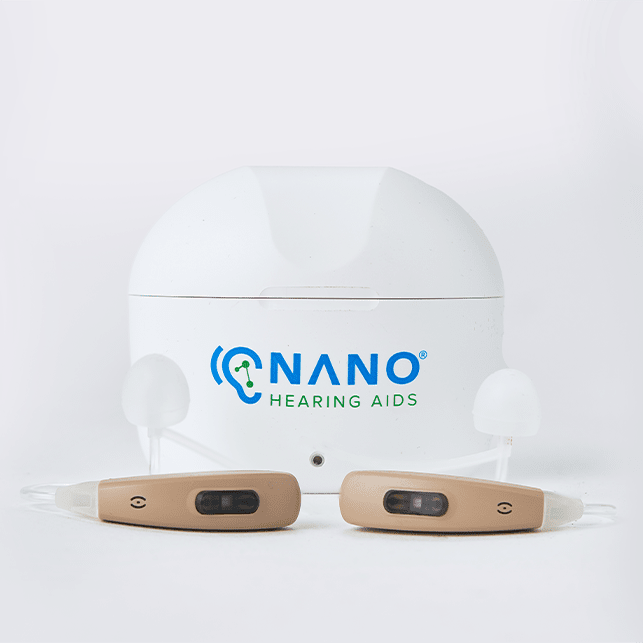Key Takeaways
Tips to Hear Better in a Restaurant
Dining out should be an enjoyable experience, but for those with hearing difficulties, restaurants are a challenging environment. The combination of background music, clattering dishes, and overlapping conversations can make it hard to hear and participate in discussions at your table. However, there are strategies you can employ to enhance your hearing capabilities in these situations. Here are a few tips to help you hear better in a restaurant:
Nano Hearing Aids are FDA-registered, Class I devices. These OTC hearing aids are designed for individuals over 18 years of age with perceived mild to moderate hearing impairment. Nano won the Top ENT Solution Provider 2023, has 24/7 customer care, and has an affordable price compared to others.

Nano Audacity® RIC OTC hearing aids
How Nano OTC Hearing Aid Helps You Hear Better in Restaurants
For those who experience hearing difficulties, a noisy restaurant can be a daunting environment. Our FDA-registered OTC hearing aids were created for adults with perceived mild to moderate hearing loss, and come with various features that can help you in noisy environments.
Directional Microphones
These microphones are engineered to focus on the sound coming from in front of you—usually the person you're trying to listen to—while reducing noise from other directions. This means that even in a busy restaurant, you can tune into your conversation more easily. Some Nano OTC behind-the-ear hearing aids utilize this technology to filter out unwanted background noise, such as chatter and clinking dishes.
Noise Reduction Capabilities
Noise reduction technology in hearing aids works to identify and lessen certain types of sound. Nano OTC hearing aids are equipped with advanced algorithms that can differentiate between speech and noise, turning down the latter while keeping the former clear. This doesn't mean the background noise will disappear completely, but it will be less intrusive, making it easier for you to follow conversations.
Discreet Design for Social Comfort
Nano OTC hearing aids are designed to be as inconspicuous as possible, allowing you to wear them without drawing attention. For example, our new completely-in-canal model, First Ear Pro CIC, is nearly invisible and works for up to 26 hours before you need to recharge it. The device comes with a set of ear tips of different sizes for precise fitting.

Nano First Ear Pro CIC OTC Hearing Aid
Bluetooth Connectivity and Smartphone Integration
Our Audacity® RIC BTE hearing aid comes with Bluetooth connectivity, allowing you to pair it with your smartphone. This integration opens up a range of possibilities, such as adjusting settings through an app and streaming audio directly to your hearing aid. And there's more; some restaurants offer apps that can connect to your hearing aid, providing you with real-time menus and specials directly in your ear—no need to struggle to hear the waiter over the din of the crowd.
Going out to eat should be a pleasurable experience, not a source of stress. With the right approach and a little help from technology like the Nano OTC hearing aids, you can transform a noisy restaurant into a setting where you can savor both the food and the conversation. So next time you're planning a night out, remember these tips and make every meal experience count.
If you’d like to learn more about our OTC hearing aids, contact our call center at (888) 310-6266!
Frequently Asked Questions (FAQ)
What are the best seating arrangements for someone with hearing difficulties?
Choosing a seat with your back to a wall can help reduce background noise. Opt for a booth if available, as the high backs can provide a buffer from ambient sounds. Sitting at a smaller table can also help, as managing conversations from fewer sources can be easier on the ears.
Furthermore, if the restaurant has round tables, they can be a good choice because they allow you to see everyone's faces, making it easier to follow along with lip reading and visual cues.
How can I ask the restaurant staff for accommodations without drawing attention?
It's all about how you communicate your needs. A simple, "Could we please have a table in a quieter area? I have some hearing challenges and would appreciate it," is both polite and direct. There's no need to feel embarrassed about your requirements; after all, you're there to enjoy the experience just like everyone else.
Can a Nano OTC hearing aid be customized for different noise environments?
No, but every Nano hearing aid has a 'noise' or 'restaurant' pre-programmed setting. This setting is designed to optimize your listening in noisy situations.
Are there specific restaurant types that are better for hearing-impaired individuals?
Restaurants with soft furnishings, such as carpets and curtains, tend to be better for those with hearing impairments because they absorb sound. Places that have separate dining areas or alcoves can also be quieter. Fast-food restaurants and those with open kitchens or live music tend to be noisier and may pose more of a challenge.
First, don't hesitate to ask someone to repeat themselves—it's a common and acceptable request. If you continue to struggle, summarize what you did hear and ask for clarification on the parts you missed. This approach shows that you're engaged in the conversation and helps to fill in the gaps without having the entire thing repeated. And remember, it's okay to let your dining companions know that you're having difficulty hearing; they can help by speaking up or rephrasing as needed. Lastly, consider the tips and technology mentioned earlier in this article.



